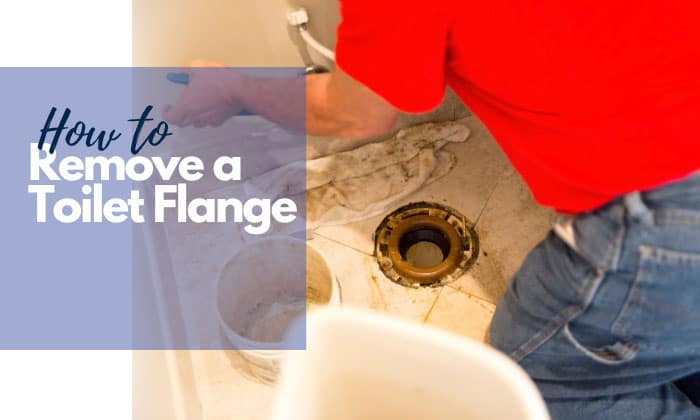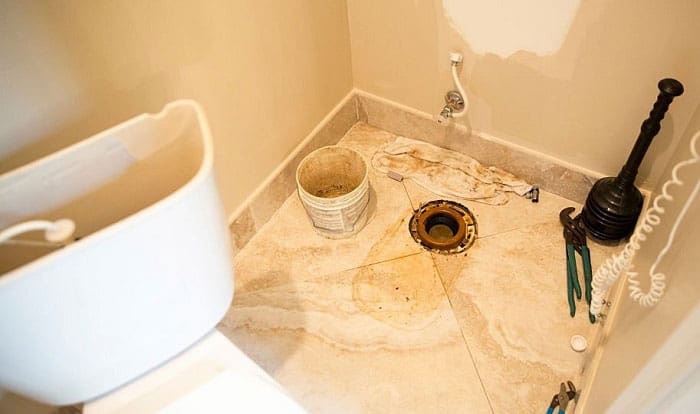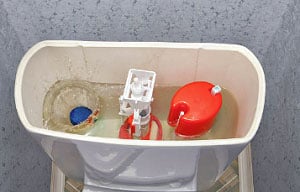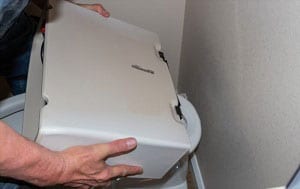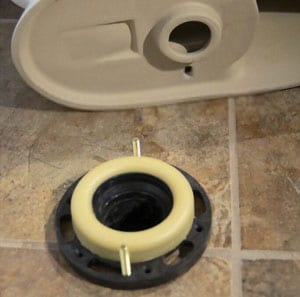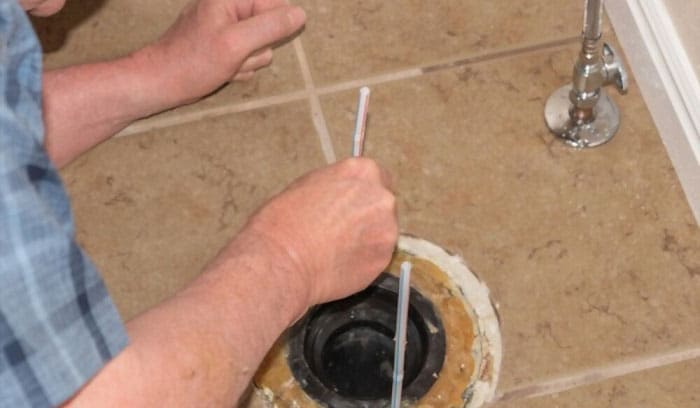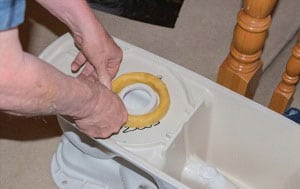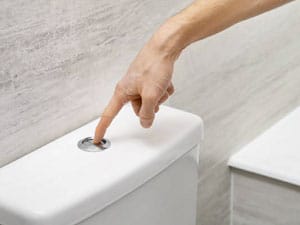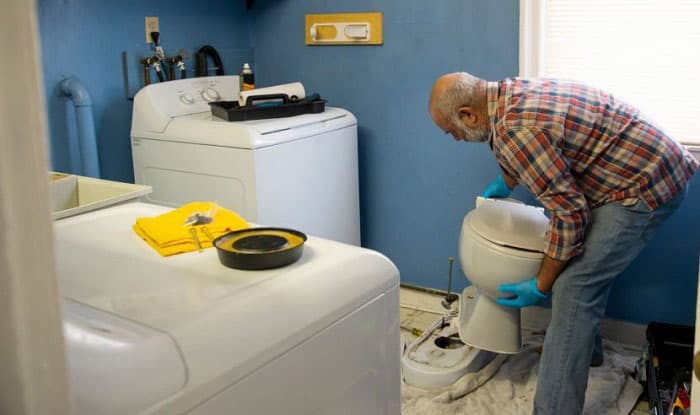The toilet is one of the most typical household plumbing types of equipment, which usually consists of a water tank, toilet bowl, and trapway. A toilet flange is a part that holds the toilet bowl, connecting the trapway to the bowl, and the bowl to the drain under the toilet floor.
So, the ever-demanding question is: how to remove a toilet flange?
Replacing the toilet flange with a new one sounds quite tricky to those who are not familiar with plumbing issues. But do not fret; we already have the solutions that you long for! These are some steps that you may follow. Read on!
Table of Contents
What to prepare
To successfully execute toilet flange removal, you need some removal tools and other necessary things, as follows:
- Putty knife
- Towels, newspaper, rag, nylon,…
- Screwdriver
- Wrench
- Wax ring
- Gloves and mask for protection
Finally, you may need support as lifting a toilet is not an easy task. You could ask a friend or your housemate to lend you a hand!
3 Easy Steps to Remove a Toilet Flange by Yourself
Step 1: Drain out the water inside the toilet
The first important step is, of course, removing all the water inside the toilet tank and bowl.
- Cutting the supply of water by turning off the water valves that provide water to the tank (you can find the valve located on the wall near or behind the toilet), and flushing several times until there is no more water left inside the toilet tank and the bowl.
- If there is a small amount of water that still lingers after many pushes, you should check if the valve is completely closed, and use a plunger to remove the remaining water inside the bowl hole.
- Next to the water valve on the wall, you should see a hose made out of metal with a braided pattern, which connects the toilet tanks with the valve. Use a wrench to loosen this hose, and with this, you are done with the first step!
Step 2: Remove the toilet
To prepare for this step, place a towel or many layers of newspaper on the floor to clean up water leakage. Later on, you can place the toilet on this towel so that the floor can stay safe from bumps and scratches.
- To remove the tank from the bowl, there are three bolts on two sides and in the middle of the toilet tank. You can loosen them with a wrench and slowly lift the toilet tank up.
- Next, detach the toilet bowl from the floor by removing the 2 nuts that connect the toilet to the floor. The bolts and nuts can be seen at the toilet pedestal’s base. They attach the toilet to the floor’s toilet flange.
Loosen the nuts on the vertical bolts using an adjustable wrench, then remove them and save them for later use.
- After removing the nuts, gently shake the commode to break the wax ring’s seal located beneath the base, and be prepared to lift the toilet bowl up!
- Now, the most crucial step in which you must be extra careful, is lifting the toilet. Grab the part between the cistern and the bowl, use your legs’ strength to lift the toilet, and place it on the towel you have prepared before. If it is too difficult, ask for a helper to avoid unwanted injuries.
Step 3: Remove the toilet flange
Now that you have removed the toilet, you may start the process of putting a new toilet flange over the old one.
- Use a rag or nylon piece to stuff it into the toilet drain’s opening to prevent smelly odors from escaping. This can also prevent things from falling down the drain pipe.
- Next, use the putty knife to scratch the old wax ring, and if you are afraid of damaging the ring, it is completely okay to just let the old wax get destroyed since you must always replace the wax with a new one.
- Attaching the flange to the floor are some screws located around the flange. Use a screwdriver to remove them and set them aside for later use (in case they are still in good shape).
Most commercial toilets today use a PVC toilet flange and are secured with a gasket. You will easily lift up the PVC flange and move it away from the drain pipe.
If the flange is glued-in or cast iron, you should hire a plumber and let them do the remaining work.
How to Install Your New Toilet Flange
Make sure you have a compatible toilet flange on hand to replace the old, torn one. Here are the steps to take after the removal job is completed.
Step 1: Purchase a suitable flange
And now it is time for a new toilet flange installation! Buy the same type of flange you are using, together with a brand new wax ring to replace the old one. You could bring your old flange to the store and ask for a new flange of a similar size.
Step 2: Install a new toilet flange
Next, you may remove the rag you have put inside the pipe, place the flange into the pipeline, secure it with the new screws (if your old screws are still in good condition, you can reuse them), and tighten the nuts thoroughly but not too tight to keep the porcelain safe.
Remember to check if the new flange fits correctly on the floor.
The wax ring should be inserted by wrapping it around the pipe hole on the flange. You can also attach the wax ring around the bottom of the toilet hole to ensure good sealing around the toilet bowl, but only if you are confident that you have enough strength and muscle to stretch the wax ring.
Consider using a toilet flange adapter in case you have difficulty installing the new flange on the drain pipeline.
Step 3: Install the toilet
The installation diagram will be the same as when you detach the toilet. After installing the flange, you should see two bolts emerging from the flange. They will line up with the holes in the toilet base.
Using your leg strength again, place the toilet back on the flange and press firmly. On the exposed bolts, attach the washers and the nuts using a wrench.
One more step before everything is complete! Reconnect the water supply by tightening the braided metal hose, turning on the water valve, and flushing the toilet several times. At this stage, remember to check for any leaks before using the toilet as usual.
FAQs
When to change a toilet flange?
If you notice water leaking from the toilet bottom, or the toilet getting a little loose from the floor, there is possibly something wrong with the inner mechanism.
Sometimes your toilet suffers from water leaks when the toilet flange breaks or it gets too old. Therefore, if you don’t remove the old toilet flange right away, not only will you face severe water damage, but your toilet may also emit an unpleasant odor.
Can I put a new toilet flange over an old one?
You can replace your old flange with a new one when there are visible cracks or any signs of deformation. If your old flange is still in good condition, you can reuse it without replacing it with a new flange.
And in any case, you always need to install a brand new wax ring.
Are toilet flanges glued in?
There are several types of toilet flanges, and normally, a common toilet flange is made of PVC.
However, replacing the flange under the toilet might be difficult to do by yourself if the type of flange is glued-in (glued to the outside or inside of the pipe) or a cast iron one. There might be extra costs incurred, more sophisticated tools and steps when you try to do it yourself. So you might as well call a plumber and let them do the hard work for you.
How much does it cost to replace a flange?
The fee to replace a toilet flange is approximately $25 to purchase the needed parts at the hardware stores, including removal tools, a repair kit, and the cost will be less than $40. However, the cast iron type of flange will be more expensive.
If you decide to hire a certified plumber, the total cost could be around $175 for the labor and the parts.
Conclusion
These are our steps and tips on how to remove a toilet flange and install a new one. If there is any problem occurring while you do the work, carefully check for deformation on the subfloor, cracks on the drain pipe, or breakage in the toilet bowl, and call a plumber to let them fix the issues.
Last but not least, we recommend you have the toilet flange replaced after 6-7 years to lessen the chance of leaks and reduce your water bills!

I’m Paulk Webb, and I work as a writer for Saveourwaterrebates. I’m happy to put in the time and effort to conduct market research to identify the most pressing issues faced by households concerning their plumbing. Feel free to check out our guides to get the most informed recommendations for how to solve your problems.


